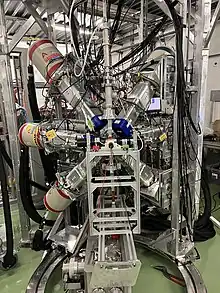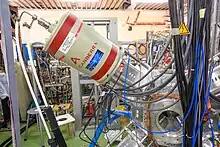| List of ISOLDE experimental setups | |
|---|---|
| COLLAPS, CRIS, EC-SLI, IDS, ISS, ISOLTRAP, LUCRECIA, Miniball, MIRACLS, SEC, VITO, WISArD | |
| Other facilities | |
| MEDICIS | Medical Isotopes Collected from ISOLDE |
| 508 | Solid State Physics Laboratory |

The ISOLDE Decay Station (IDS) is a permanent experiment located in the ISOLDE facility at CERN. The purpose of the experiment is to measure decay properties of radioactive isotopes using spectroscopy techniques for a variety of applications, including nuclear engineering and astrophysics.[1] The experimental setup has been operational since 2014.[2]
Experiment systems can be coupled to the station for different decay measurements, using techniques such as fast timing, and time-of-flight.[3][4] The IDS is able to study a range of nuclei, from light to heavy.
Background
Fast detectors with fast-timing electronics are needed to overcome the short nuclear lifetimes of radioisotopes. This method is known as the fast-timing technique, and is used for sequential decay chains by measuring time differences and delays.[5] The detectors used in this technique must be able to accurately measure the time a particle is detected, leading to a fast response time. Scintillation detectors and photomultiplier tubes (PMTs) are most often employed for this technique.[6]
In charged-particle spectroscopy, detectors are used to determine the position and energy of charged particle, as they create measurable electron-hole pairs when they pass through. As neutrons are not charged particles, to measure their motion, neutron scattering processes must be observed. Time-of-flight detectors can be used to measure the time if takes for a neutron to travel from a sample to the detector, and calculate the neutron's energy.[7] Alternatively, scintillation detectors are also used to determine the neutron's energy, by converting the energy to photons and measuring the intensity of the produced light.[8]
Experiment setup
The RC4 beamline in the ISOLDE facility, which can use the beam from either General Purpose Separator (GPS) or High Resolution Separator (HRS), is connected to the IDS.[9] The ion beam is collimated and, in a vacuum chamber, is implanted on tape, which is moved either manually or automatically depending on the specified implantation time.[10] A movable Faraday cup is located at the entrance and exit of the vacuum chamber.[11]

The base IDS setup consists of four high-purity germanium (HPGe) clover detectors, which can be retracted and inserted manually and one HPGe Miniball cluster detector. These detectors form a gamma detector array with good efficiency and energy resolution.[12][2] Each detector has a liquid nitrogen cooling canister, and consists of four HPGe crystals. In April 2023, a new support structure was installed at IDS, which allowed up to 15 extra detectors to be mounted at various angles and distances.[1] The Data Acquisition System (DAQ) used to read data from the experiment, consists of a dedicated NUTAQ system.[2][1]
The specific configurations of the IDS setup correspond to different experimental purposes. These configurations include: high efficiency beta-gamma, fast-timing, charged-particle spectroscopy, and neutron spectroscopy.[13][14][15][16]
High-efficiency beta-gamma setup
The standard high beta-gamma efficiency configuration of the IDS consists of five HPGe clover detectors, one placed in very close proximity (60 mm) to the implantation point, and the rest slightly further away (75 mm). Signals are induced in a plastic scintillator by beta particles, which are read by two PMTs.[3]
Fast-timing setup
The standard fast-timing spectroscopy set-up consists of a thin plastic scintillator to measure beta particles, two LaBr3(Ce) detectors, and four HPGe clover detectors. This method has high precision measurements for low-intensity beams and can achieve good efficiency and time resolution.[14]
Charged-particle spectroscopy setup
The standard IDS charged-particle spectroscopy setup consists of a silicon detector array surrounding the tape onto which the beam is implanted. Around this array, the four HPGe clover detectors are placed, which allows high-efficiency detection of both charged particles and gamma rays.[17]
Neutron spectroscopy setup
The IDS neutron spectroscopy setup, based on the VANDLE (Versatile Array of Neutron Detectors at Low Energy) detector, is dedicated to detection of neutron time-of-flight. The setup consists of three scintillating detector modules of different sizes, with the scintiliating plastic bars coupled to PMTs.[18]
Results
The results from the IDS permanent experimental setup are useful for multiple areas of physics, in particularly for astrophysics. The experimental data taken by the IDS when measuring the probability of a particular delayed alpha decay, improved upon its previous result.[9] This nuclear reaction is one that occurs in red giant stars, and is related to stellar evolution.[19][20]
Results from experiments performed using IDS, have also been used to study isotope properties as well as confirm theoretical models.[21][22]
In 2023, a multiple-particle emission experiment was successful performed at the IDS for the first time.[23][11] The aim of the analysis for this experiment is to study a specific decay channel that leads to gamma ray de-excitations from excited states of 28Si.[11]
External links
References
- 1 2 3 "ISOLDE Decay Station (IDS) | ISOLDE". isolde.cern. Retrieved 2023-07-21.
- 1 2 3 Razvan, Lics (3 Oct 2017). "Development of the ISOLDE Decay Station and γ spectroscopic studies of exotic nuclei near the N=20 "Island of Inversion"". Cern-Isolde.
- 1 2 IDS Collaboration; Lică, R.; Mach, H.; Fraile, L. M.; Gargano, A.; Borge, M. J. G.; Mărginean, N.; Sotty, C. O.; Vedia, V.; Andreyev, A. N.; Benzoni, G.; Bomans, P.; Borcea, R.; Coraggio, L.; Costache, C. (2016-04-04). "Fast-timing study of the $l$-forbidden $1/{2}^{+}\ensuremath{\rightarrow}3/{2}^{+} M1$ transition in $^{129}\mathrm{Sn}$". Physical Review C. 93 (4): 044303. doi:10.1103/PhysRevC.93.044303. hdl:10138/164553.
- ↑ Paulauskas, S. V.; Madurga, M.; Grzywacz, R.; Miller, D.; Padgett, S.; Tan, H. (2014-02-11). "A digital data acquisition framework for the Versatile Array of Neutron Detectors at Low Energy (VANDLE)". Nuclear Instruments and Methods in Physics Research Section A: Accelerators, Spectrometers, Detectors and Associated Equipment. 737: 22–28. doi:10.1016/j.nima.2013.11.028. ISSN 0168-9002.
- ↑ Phrompao, Jindaratsamee. "Test and calibration of the IDS fast-timing electronics" (PDF). Chiang Mai University, Thailand.
- ↑ Deloncle, I; Roussière, B; Cardona, M A; Hojman, D; Kiener, J; Petkov, P; Tonev, D; Venkova, Ts (2010-01-01). "Fast timing: Lifetime measurements with LaBr 3 scintillators". Journal of Physics: Conference Series. 205: 012044. doi:10.1088/1742-6596/205/1/012044. hdl:11336/101874. ISSN 1742-6596.
- ↑ "Neutron Spectroscopy". Spectroscopy. Spectroscopy-12-01-2010. 25 (12). 2010-12-01.
- ↑ Scionix (8 Oct 2013). "Neutron detection with scintillators" (PDF). scionix.nl. Retrieved 25 July 2023.
- 1 2 Kirsebom, O. S.; Tengblad, O.; Lica, R.; Munch, M.; Riisager, K.; Fynbo, H. O. U.; Borge, M. J. G.; Madurga, M.; Marroquin, I.; Andreyev, A. N.; Berry, T. A.; Christensen, E. R.; Fernández, P. Díaz; Doherty, D. T.; Van Duppen, P. (2018-10-03). "First Accurate Normalization of the $\ensuremath{\beta}$-delayed $\ensuremath{\alpha}$ Decay of $^{16}\mathrm{N}$ and Implications for the $^{12}\mathrm{C}(\ensuremath{\alpha},\ensuremath{\gamma})^{16}\mathrm{O}$ Astrophysical Reaction Rate". Physical Review Letters. 121 (14): 142701. arXiv:1804.02040. doi:10.1103/PhysRevLett.121.142701. PMID 30339438.
- ↑ Jenkinson, Megan (September 2017). "Laser Spectroscopy Of Neutron-Deficient Bismuth Isotopes" (PDF). University of York.
- 1 2 3 Marroquin, I.; Borge, M.J.G.; Ciemny, A.A.; de Witte, H.; Fraile, L.M.; Fynbo, H.O.U.; Garzón-Camacho, A.; Howard, A.; Johansson, H.; Jonson, B.; Kirsebom, O.S.; Koldste, G.T.; Lica, R.; Lund, M.V.; Madurga, M. (2016). "Multi-particle Emission from ${^{31}}$Ar at ISOLDE". Acta Physica Polonica B. 47 (3): 747. doi:10.5506/APhysPolB.47.747. hdl:10261/151807. ISSN 0587-4254.
- ↑ "Clover™ Detectors Four Coaxial Germanium Detectors". Mirion. Retrieved 2023-07-21.
- ↑ Lică, R.; Rotaru, F.; Borge, M. J. G.; Grévy, S.; Negoiţă, F.; Poves, A.; Sorlin, O.; Andreyev, A. N.; Borcea, R.; Costache, C.; De Witte, H.; Fraile, L. M.; Greenlees, P. T.; Huyse, M.; Ionescu, A. (2019-09-11). "Normal and intruder configurations in Si 34 populated in the β − decay of Mg 34 and Al 34". Physical Review C. 100 (3): 034306. doi:10.1103/PhysRevC.100.034306. hdl:10138/312141. ISSN 2469-9985. S2CID 201698163.
- 1 2 Fraile, L M (2017-09-01). "Fast-timing spectroscopy at ISOLDE". Journal of Physics G: Nuclear and Particle Physics. 44 (9): 094004. doi:10.1088/1361-6471/aa8217. ISSN 0954-3899.
- ↑ Lynch, K. M.; Cocolios, T. E.; Althubiti, N.; Farooq-Smith, G. J.; Gins, W.; Smith, A. J. (2017-02-01). "A simple decay-spectroscopy station at CRIS-ISOLDE". Nuclear Instruments and Methods in Physics Research Section A: Accelerators, Spectrometers, Detectors and Associated Equipment. 844: 14–18. doi:10.1016/j.nima.2016.11.024. ISSN 0168-9002.
- ↑ Xu, Z. Y.; Madurga, M.; Grzywacz, R.; King, T. T.; Algora, A.; Andreyev, A. N.; Benito, J.; Berry, T.; Borge, M. J. G.; Costache, C.; De Witte, H.; Fijalkowska, A.; Fraile, L. M.; Fynbo, H. O. U.; Gottardo, A. (2023-07-14). "$\ensuremath{\beta}$-delayed neutron spectroscopy of $^{133}\mathrm{In}$". Physical Review C. 108 (1): 014314. arXiv:2303.12173. doi:10.1103/PhysRevC.108.014314. S2CID 259919994.
- ↑ IDS Collaboration; Lund, M. V.; Andreyev, A.; Borge, M. J. G.; Cederkäll, J.; De Witte, H.; Fraile, L. M.; Fynbo, H. O. U.; Greenlees, P. T.; Harkness-Brennan, L. J.; Howard, A. M.; Huyse, M.; Jonson, B.; Judson, D. S.; Kirsebom, O. S. (Oct 2016). "Beta-delayed proton emission from 20Mg". The European Physical Journal A. 52 (10). arXiv:1506.04515. doi:10.1140/epja/i2016-16304-x. ISSN 1434-6001. S2CID 254112622.
- ↑ José Rafael Arce, G. (26 August 2015). "On the simulation of limit thresholds for ISOLDE decay station neutron detector" (PDF). Isotope Mass Separator On-Line Facility (ISOLDE) and Universidad de Costa Rica.
- ↑ "The ISOLDE Decay Station (IDS) gives improved results on delayed alpha decay for 16N. New paper in Physical Review Letters". phys.au.dk. 2018-09-28. Retrieved 2023-07-25.
- ↑ Buchmann, L.; Ruprecht, G.; Ruiz, C. (2009-10-21). "$\ensuremath{\beta}$-delayed $\ensuremath{\alpha}$ decay of $^{16}\mathrm{N}$". Physical Review C. 80 (4): 045803. doi:10.1103/PhysRevC.80.045803.
- ↑ IDS Collaboration; Stryjczyk, M.; Andel, B.; Andreyev, A. N.; Cubiss, J.; Pakarinen, J.; Rezynkina, K.; Van Duppen, P.; Antalic, S.; Berry, T.; Borge, M. J. G.; Clisu, C.; Cox, D. M.; De Witte, H.; Fraile, L. M. (2020-08-18). "Decay studies of the long-lived states in $^{186}\mathrm{Tl}$". Physical Review C. 102 (2): 024322. doi:10.1103/PhysRevC.102.024322. hdl:10261/225991. S2CID 219260371.
- ↑ IDS Collaboration; Lică, R.; Benzoni, G.; Rodríguez, T. R.; Borge, M. J. G.; Fraile, L. M.; Mach, H.; Morales, A. I.; Madurga, M.; Sotty, C. O.; Vedia, V.; De Witte, H.; Benito, J.; Bernard, R. N.; Berry, T. (2018-02-05). "Evolution of deformation in neutron-rich Ba isotopes up to $A=150$". Physical Review C. 97 (2): 024305. doi:10.1103/PhysRevC.97.024305. hdl:10138/234747.
- ↑ "Greybook". greybook.cern.ch. Retrieved 2023-07-25.